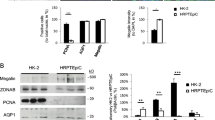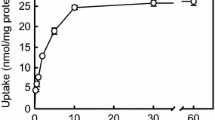Summary
We have chosen the MDCK cell line to investigate aldosterone action on H+ transport and its role in regulating cell membrane K+ conductance (G Km ). Cells grown in a monolayer respond to aldosterone indicated by the dose-dependent formation of domes and by the alkalinization of the dome fluid. The pH sensitivity of the plasma membrane K+ channels was tested in “giant cells” fused from individual MDCK cells. Cytoplasmic pH (pH i ) andG K m were measured simultaneously while the cell interior was acidified gradually by an extracellular acid load. We found a steep signoidal relationship between pH i andG K m (Hill coefficient 4.4±0.4), indicating multiple H+ binding sites at a single K+ channel. Application of aldosterone increased pH i within 120 min from 7.22±0.04 to 7.45±0.02 and from 7.15±0.03 to 7.28±0.02 in the absence and presence of the CO2/HCO −3 buffer system, respectively. We conclude that the hormone-induced cytoplasmic alkalinization in the presence of CO2/ HCO −3 is limited by the increased activity of a pH i -regulating HCO −3 extrusion system. SinceG K m is stimulated half-maximally at the pH i of 7.18±0.04, internal H+ ions could serve as an effective intracellular signal for the regulation of transepithelial K+ flux.
Similar content being viewed by others
References
Ammann D., Lanter, F., Steiner, R.A., Schultess, P., Shijo, Y., Simon, W. 1981. Neutral carrier based hydrogen ion selective microelectrode for extra and intracellular studies.Anal. Chem. 53:2267–2269
Baker, M.E., Fanestil, D.D. 1977. Effect of protease inhibitors and substrates on deoxycorticosterone binding to its receptor in dog MDCK cells.Nature (London) 269:810–812
Basnett, S., Duncan, G. 1988. The influence of pH on membrane conductance and intracellular resistance in the rat lens.J. Physiol. (London) 398:507–521
Baud, C., Barish, M.E. 1984. Changes in membrane hydrogen and sodium conductances during progesterone-induced maturation ofAmbystoma oocytes.Dev. Biol. 105:423–434
Blatz, A.L. 1984. Asymmetric proton block of inward rectifier K channels in skeletal muscle.Pfluegers Arch. 401:402–407
Cobb, M.H., Yang, C.H., Jefferson, D.M., Panikowski, E., Scott, W.N. 1982. Mineralocorticoid-induced membrane proteins in MDCK cells.Mol. Cell. Endocrinol. 27:129–137
Cook, D.L., Ikeuchi, M., Fujimoto, W.Y. 1984. Lowering of pH i inhibits Ca2+-activated K+ channels in pancreatic B-cells.Nature (London) 311:269–271
Fanestil, D.D. 1968. Mode of spironolactone action: Competitive inhibition of aldosterone binding to kidney mineralocorticoid receptors.Biochem. Pharmacol. 17:2240–2242
Foster, E.S., Budinger, M.E., Hayslett, J.P., Binder, H.J. 1986. Ion transport in proximal colon of the rat.J. Clin. Invest. 77:228–235
Herzlinger, D.A., Easton, T.G., Ojakian, G.K. 1982. The MDCK epithelial cell line expresses a cell surface antigen of the kidney distal tubule.J. Cell Biol. 93:269–277
Hunter, M., Oberleithner, H., Henderson, R.M., Giebisch, G. 1988. Whole cell currents in single early distal tubule cells.Am. J. Physiol. 255:F699-F703
Keller, S.K., Jentsch, T.J., Koch, M., Wiederholt, M. 1986. Interactions of pH and K+ conductance in cultured bovine retinal pigment epithelial cells.Am. J. Physiol. 250:C124-C137
Kersting, U., Joha, H., Steigner, W., Gassner, B., Gstraunthaler, G., Pfaller, W., Oberleithner, H. 1988. Fusion of cultured dog kidney (MDCK) cells: I. Technique, fate of plasma membranes and cell nuclei.J. Membrane Biol. 111:37–48
Kinoshita, Y., Fukase, M., Miyauchi, A., Nakada, M., Takenaka, M., Fujita, T. 1986. Effect of aldosterone on dome formation by MDCK monolayer.Endocrinol Jpn. 33:317–322
Kolb, H.A., Brown, C.D.A., Murer, H. 1985. Identification of a voltage-dependent anion channel in the apical membrane of a Cl−-secretory epithelium (MDCK).Pfluegers Arch. 403:262–265
Kolb, H.A., Paulmichl, M., Lang, F. 1987. Epinephrine activates outward rectifying K-channel in Madin-Darby kidney cells.Pfluegers Arch. 408:584–591
Kurtz, I., Golchini, K. 1987. Na+-independent Cl−-HCO −3 exchange in Madin-Darby canine kidney cells.J. Biol. Chem. 262(19:4516–4520
Lee, S.C., Steinhardt, R.A. 1981. pH changes associated with meiotic maturation in oocytes ofXenopus laevis.Dev. Biol. 85:385–369
Leighton, J., Estes, L.W., Mansukani, S., Brada, Z. 1970. A cell line derived from dog kidney (MDCK) exhibiting qualities of papillary adenocarcinoma.Cancer 26:1022–1028
Lever, J.E. 1981. Regulation of dome formation in kidney epithelial cell cultures.Ann. N.Y. Acad. Sci. 372:371–381
Ludens, J.H., Vaughn, D.A., Mawe, R.C., Fanestil, D.D. 1978. Specific binding of deoxycorticosterone by canine kidney cells in culture.J. Steroid Biochem. 9:17–21
Madin, S.H., Darby, N.B. 1958. CCL-34,as catalogued in: American Type Culture Collection Catalog of Strains. H.O. Hatt, editor. 1975. Vol. 2, pp. 47. Library of Congress, Rockville, MD
Misfeldt, D.S., Hamamoto, S.T., Pitelka, D.R. 1976. Transepithelial transport in cell culture.Proc. Natl. Acad. Sci. USA 73(4:1212–1216
Oberleithner, H., Kersting, U., Hunter, M. 1988. Cytoplasmic pH determines K+ conductance in fused renal epithelial cells.Proc. Natl. Acad. Sci. USA 85:8345–8349
Oberleithner, H., Weigt, M., Westphale, H.-J., Wang, W. 1987. Aldosterone activates Na+/H+ exchange and raises cytoplasmic pH in target cells of the amphibian kidney.Proc. Natl. Acad. Sci. USA 84:1464–1468
Paulmichl, M., Gstraunthaler, G., Lang, F. 1985. Electrical properties of Madin-Darby canine kidney cells. Effects of extracellular potassium and bicarbonate.Pfluegers Arch. 406:367–371
Rodeau, J.L., Vilain, J.P. 1987. Changes in membrane potential, membrane resistance, and intracellular H+, K+, Na+ and Cl− activities during the progesterone-induced maturation of Urodele amphibian oocytes.Dev. Biol. 120:481–493
Rosario, L.M., Rojas, E. 1986. Modulation of K+ conductance by intracellular pH in pancreatic β-cells.FEBS Lett. 200(1:203–209
Saier, M.H. 1981. Growth and differentiated properties of a kidney epithelial cell line (MDCK):Am. J. Physiol. 240:C106-C109
Selvaggio, A.M., Schwartz, J.H., Bengele, H.H., Alexander, E.A. 1986. Kinetics of the Na+−H+ antiporter as assessed by the change in intracellular pH in MDCK cells.Am. J. Physiol. 251:C558-C562
Simmons, N.L. 1978. Hormone stimulation of net transepithelial Na+ transport in cell culture.J. Physiol. (London) 276:28P-29P
Wang, W., Henderson, R.M., Geibel, J., White, S., Giebisch, G. 1989. Mechanism of aldosterone-induced increase of K+ conductance in early distal renal tubule cells of the frog.J. Membrane Biol. (in press)
Wanke, E., Carbone, E., Testa, P.L. 1979. K+ conductance modified by a titratable group accessible to protons from the intracellular side of the squid axon membrane.Biophys. J. 26:319–324
Weigt, M., Dietl, P., Silbernagl, S., Oberleithner, H. 1987. Activation of luminal Na+/H+ exchange in distal nephron of frog kidney: An early response to aldosterone.Pfluegers Arch. 408:609–614
Yang, C.-P.H., Cobb, M.H., Jefferson, D.M., Scott, W.N. 1981. Effects of mineralocorticoids on RNA and protein synthesis in MDCK cells.Ann. N.Y. Acad. Sci. 342:470–472
Author information
Authors and Affiliations
Rights and permissions
About this article
Cite this article
Oberleithner, H., Kersting, U., Silbernagl, S. et al. Fusion of cultured dog kidney (MDCK) cells: II. Relationship between cell pH and K+ conductance in response to aldosterone. J. Membrain Biol. 111, 49–56 (1989). https://doi.org/10.1007/BF01869208
Received:
Revised:
Issue Date:
DOI: https://doi.org/10.1007/BF01869208




